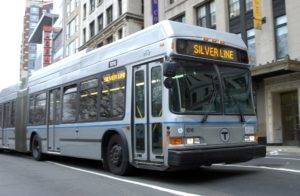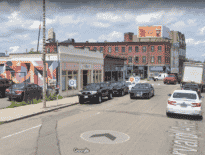The MBTA will add a “circulator” shuttle bus and expand Silver Line service to help connect Chinatown to other destinations during the upcoming Orange Line shutdown, T General Manager Steve Poftak said Thursday.
After receiving substantial feedback from city of Boston officials and riders, Poftak said the MBTA would bulk up service alternatives for Chinatown and Tufts Medical Center, two downtown Boston stations that will lose subway access Friday night when the Orange Line goes dark for 30 days.
The T will run a supplemental shuttle bus connecting Government Center, Tufts Medical Center, and Chinatown in a loop every 30 minutes between 5 a.m. and 7 a.m. and between 8 p.m. and 1 a.m., Poftak said. The Silver Line 4 route will also add an outbound stop at Chinatown, and Poftak said MBTA officials are working on boosting frequency on that line as well.
During the unprecedented shutdown, the MBTA plans to launch a massive fleet of shuttle buses in two legs, one making stops between Forest Hills in Jamaica Plain and Boston’s Copley station and the other connecting Oak Grove in Malden with Government Center. The T will not run shuttle buses connecting those two Boston endpoints, and riders will instead be urged to switch to the Green Line for downtown service.
“Running buses through the heart of downtown Boston is extraordinarily challenging,” Poftak said during a Greater Boston Chamber of Commerce webinar Thursday. “We’ve tried to address that by piggybacking on the Green Line here. We’re also going to try and run as much additional service on the core of the Green Line as we can as well to absorb the needs of our customers.”
Poftak said the Green Line’s Boylston Station, which is “roughly a block away” from both the Chinatown and Tufts Medical Center stops on the Orange Line, is not accessible, so the T will also make vans available at Park Street and Copley stations for riders with accessibility needs.
During his appearance before the chamber, Poftak said the decision to shut the Orange Line down so suddenly – a source of great consternation for business leaders and everyday T riders, alike – was driven by the agency’s interpretation of federal safety inspectors directives, but also
“Overall, the strategic direction that putting in speed restrictions and then scheduling work to address the issue over time was not the approach [the Federal Transit Administration] wanted us to take,” Poftak told Boston Chamber CEO Jim Rooney, himself a former top MBTA executive who began his career as a nighttime maintenance worker.
In addition, Poftak said, the T found out it would not be able to secure the 200-some buses it would need for a month-long diversion project if it did not act right away.
“The contract bus market is not that liquid,” Poftak said. “To do this is requiring us to get every available bus east of the Mississippi. We have drivers coming in from out of town and getting put up in hotels.”
At a Friday morning briefing on the shutdown at the T’s Forest Hills station, Poftak revealed an additional metric for the shutdown: at least six of the slow zones on the Orange Line, indicative of seriously deteriorated track conditions, would be fixed during the diversion in addition to the other benefits he and other state officials had already outlined. The T has a “bullpen” of projects the agency can add to the to-do list during the 30-day shutdown in case its work goes quickly, he added, and would truncate the list of projects involved if it turns out work goes too slowly.
“This is a bold and decisive step to make major and substantial progress on a number of projects on the Orange Line that will provide our customers safer, faster and more reliable service,” Poftak said. “We did not make this decision lightly. We know it will be disruptive and we thank everyone for their patience.”
In response to a reporter’s question, Poftak said he had “basically ruled out” doing another whole-line shutdown any time in the near future.
Poftak and state Transportation Secretary Jamey Tesler praised state officials at MassDOT and municipal officials, particularly in Boston, for their work arranging temporary bus lanes and other emergency modifications to accommodate shuttle buses and riders shifting to bicycles and the commuter rail during the shutdown.
Boston officials have announced a range of street closures to make sure shuttle buses don’t get stuck in traffic, including:
- State Street between Congress Street and Washington Street
- Dartmouth Street between St. James Street and Boylston Street
- Washington Street (northbound-only) between Arborway and Williams Street
Temporary bus lanes and parking bans have also been put in place in a number of places where shuttle buses are expected to drop off and pick up riders, and riders waiting for shuttle buses will have tents to wait under in case of stormy weather.
Transportation officials added Friday that plans to move riders and help them navigate during the shutdown will be monitored and improved as needed with help from advocacy groups and ordinary riders’ observations.
“We will continue to listen” and evolve the plan, Tesler said.







